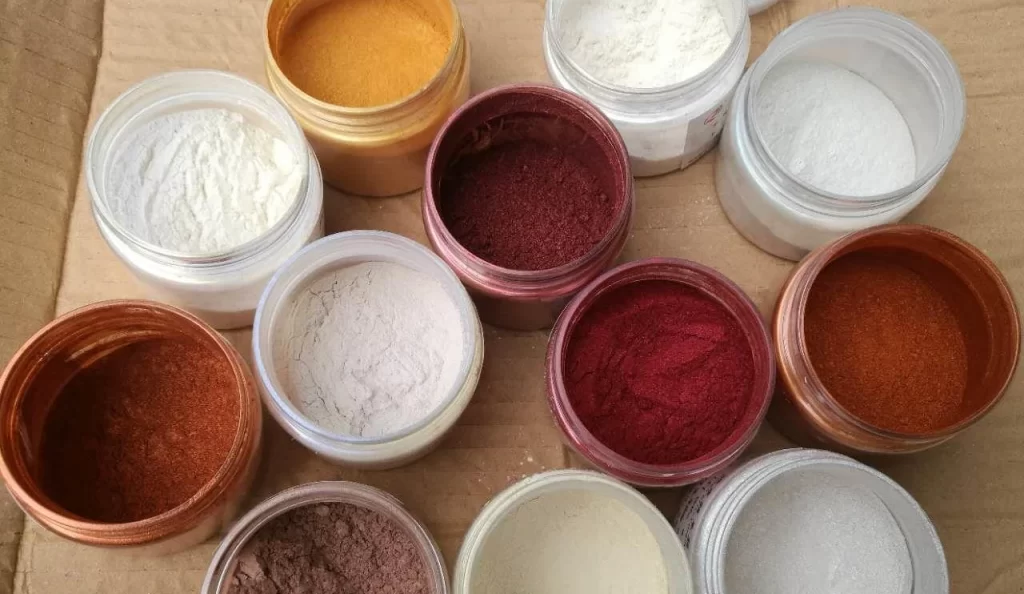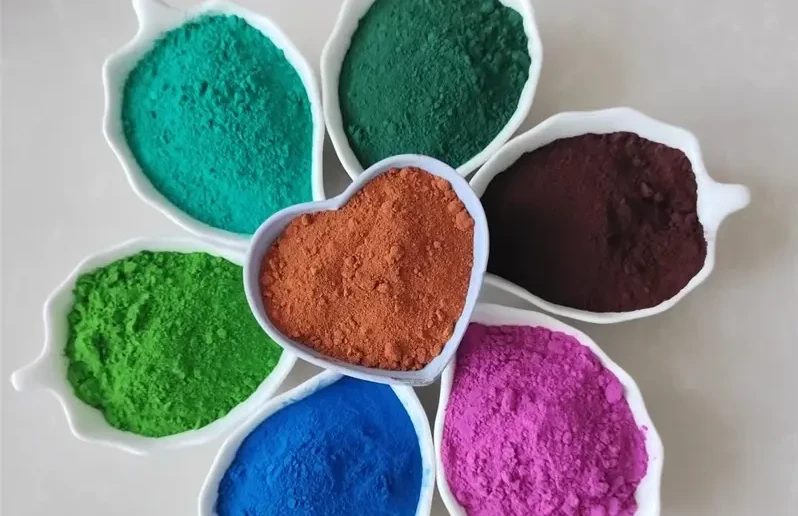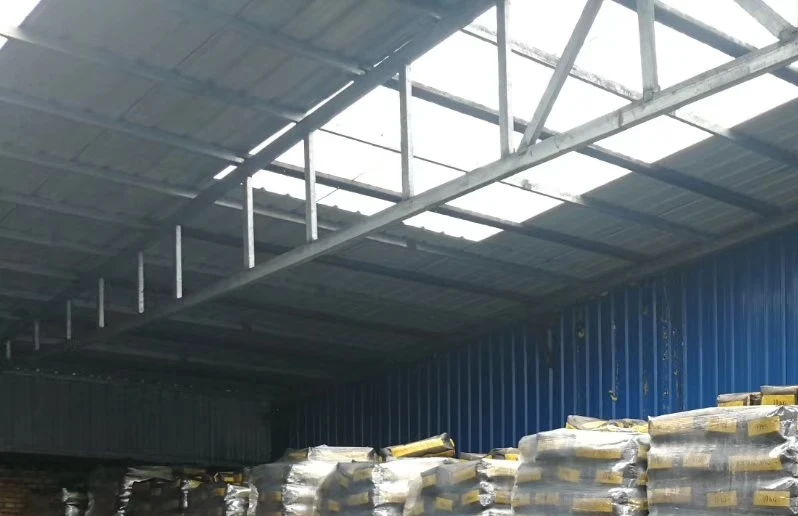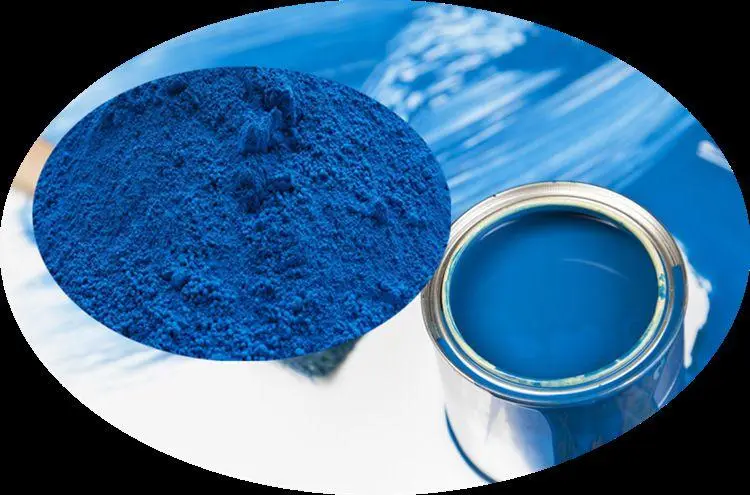What are industrial pigments?
Industrial pigments are for industrial products. In addition to visible colors in industrial production, they are used for product marking, anticorrosive coating, vehicle coating, etc. Typically, industrial color pigments are made by mixing complexing agents, solvents and paints. They are organic or inorganic pigments, with good light fastness and maintainability. Industrial colour pigments are also applied in pharmaceutical manufacturing, printing and coating.

What are the types of industrial colorants?
I. Organic dyes
Organic dyes are made from organic synthetic materials. They feature bright color, high gloss and high dyeing reliability. They are not prone to fading in the presence of light. Organic dyes usually have high hydrophilicity and dispersibility. They can be well dissolved in water or other solvents. They are one main type of industrial colorants.
II. Inorganic dyes
Inorganic dyes are made from inorganic compounds or dissolved minerals. They have light colors, but high color stability. They are not easy to decomposed. In addition, they are not easy to face in acids or alkalis. Therefore, inorganic dyes are applied in textile, plastics, etc.
III. Fluorescent dyes
These dyes are fluorescent if they are irradiated in UV light. They feature bright color, high brightness and good labeling property. They are widely applied in medical, biology, material science and other fields.
IV. Natural dyes
Natural dyes are extracted from natural plants, animals or minerals. They are mainly composed of natural organic compounds and inorganic compounds. They have stable colors. Some natural dyes have medical and health effects. Therefore, they are also one main type of industrial colorants.
In general, there are many types of industrial colorants. Different dyes are applicable to different materials and scenarios. The development and use of suitable industrial colorants have positive effects on product quality, energy saving, consumption reduction, etc.
How do industrial color pigments differ from regular pigments?
I. Purposes
Industrial color pigments are primarily applied in machinery, electrical appliances, automobiles, ships, construction, etc. They mainly protect the surface of coated objects from environmental corrosion, wear, chemical corrosion, etc. Regular pigments are mainly applied in home appliances and decoration, such as furniture, doors and windows.
II. Properties
1. Appearance
Industrial color pigments are mainly for object protection, so surfaces are usually rigid, smooth and delicate. Regular pigments are for rich colors, various patterns and delicate shapes.
2. Adhesion
Industrial color pigments are often applied on equipment for high-strength surfaces. They can protect surfaces from wear, heat, chemical corrosion, etc. Industrial color pigments have high segregation strength. Regular pigments have low adhesion. They only need to meet decoration requirements.
3. Hardness
Objects to be treated with industrial pigments are usually used under harsh conditions. They have high requirements for hardness and wear resistance. Therefore, industrial color pigments with high hardness and rigidity are often used. Regular pigments are for aesthetic effects on the premise of moderate operability.
4. Corrosion resistance
Industrial pigments usually have excellent corrosion resistance. They can effectively protect coated objects from damage by chemical, acid or alkali corrosion, etc. Instead, regular pigments are generally for weather fastness and aesthetic effects.
What are the most common types of industrial colour pigments?
1. Organic pigments
Organic pigments refer to the pigments dissolved or dispersed in organic matters. They have the advantages of good color rendering, transparency, stability and light fastness. They are often applied in coatings, plastics, rubber, printing ink, cosmetics, food packaging, etc.
2. Inorganic pigments
Inorganic pigments are chemicals composed of metallic or non-metallic elements, usually in the powder form. They are applicable to building materials (e.g. ceramic, glass and bricks), printing, coating, paper, etc.
3. Disperse pigments
Disperse dyes are water-soluble. They are applicable to textile, leather products, batteries, etc.

How are industrial pigments manufactured?
I. Material selection
Material selection is the first step in pigment production. High-quality raw materials can ensure the stable quality of pigments. Suitable raw materials should be selected based on the purpose, color, transparency, etc. Common raw materials for pigments include pigment powder, jute, carbon black, titanium dioxide and so on.
II. Grinding
Grinding is indispensable in pigment production. After grinding and mixing, raw materials are ground in a grinder. The purpose of grinding is to make small and uniform particles as much as possible, so that pigments can be well dispersed. The grinding time should be adjusted according to specific conditions.
III. Dispersion
Dispersion is a critical process in pigment production and important factor affecting the pigment quality. After grinding, the pigment is put into a dispersing machine, and the dispersing agent is added for dispersion, so that the pigment is finer and more uniform. Based on the purpose and requirement of pigments, the type and dosage of the dispersing agent should be adjusted to ensure dispersion effects.
IV. Filtration
After dispersion, the pigment may contain some residual particles that are not fully ground, so filtration is required. Filtration can ensure the cleanliness and stability of pigments. A filter should be selected reasonably according to the viscosity and particle size of pigment.
V. Drying
The produced pigment should be dried for curing. Common drying methods include natural drying, air drying, baking, etc. According to the pigment type and process requirements, the drying time and temperature should be adjusted to ensure the dryness of pigments.

What precautions should be taken when producing industrial pigments?
Precautions
1. Do not use low-quality raw materials to avoid negative impact on the product quality.
2. Strictly follow the production process. Do not make any changes or reduce any processes.
3. Strictly control the production environment and keep production equipment clean.
4. Ensure the quality of dispersing agents. Do not use inferior dispersing agents, so that pigments are well dispersed.
5. Strictly control the amount of pigment used to avoid waste.
In short, pigment product involves multiple steps. Strictly follow the operation process and precautions to produce better and more stable pigments.
How to manufacture industrial pigments environmentally?
I. Reduce wastewater discharge
Wastewater discharge is inevitable during chemical pigment production. In order to prevent environmental pollution caused by wastewater, measures should be taken to reduce wastewater discharge. Specific measures include: increasing the production efficiency to reduce wastewater; carrying out pretreatment to reduce the content of harmful substances; and introducing new treatment technologies to improve the wastewater treatment efficiency, etc.
II. Use of environmentally friendly materials
Use of environmentally friendly materials is quite important during chemical pigment production. Environmentally friendly materials refer to the materials that are pollution-free and conducive to recycling. Use of environmentally friendly materials can reduce waste emissions and environmental pollution. For example, we can use degradable materials instead of plastic packages, or use more environmentally friendly auxiliaries.
III. Use of renewable energy
A lot of energy is required during chemical pigment production. Use of renewable energy is an important environmental protection measure. Renewable energy refers to the energy that can be recycled, such as solar energy, wind energy, water energy and so on.
IV. Full utilization of resources
A lot of resources are required during chemical pigment production, such as water, electricity and coal. In order to protect the environment, we need to make full use of resources as much as possible and reduce waste. For example, we can recycle water and increase the energy efficiency of equipment during production.

What are the primary applications of industrial pigments?
1. Coatings and paints
Coatings and paints are main applications of industrial pigments. Industrial pigments of different colors can be applied in the fields of interior coatings, exterior wall coatings, industrial coatings, etc. In addition to finishing, chemical pigments have the effects of heat insulation, anticorrosion, waterproofing, etc.
2. Plastics and rubber
Industrial pigments can enhance, adjust and stabilize the colors of plastics and rubber. By using chemical pigments of different colors, plastic and rubber products are more durable and elegant.
3. Paper and printing ink
Industrial pigments are widely applied in paper and printing ink. For example, industrial pigments of yellow, red, blue, black and other colors can be used in printing of posters, magazines and so on.
4. Food packaging
Industrial pigments can be used in the food packaging field. For candy, chocolate and other food with a color background, industrial pigments of different colors are more attractive.
Industrial pigments are widely applied for color enhancement, color adjustment, aesthetics and personalized effects in different fields. Although chemical pigments have rich colors and extensive applications, we should pay attention to the dosage and ratio to avoid unnecessary harm to the human body and environment.
How do you ensure color consistency in industrial pigments?
Controlled lighting
Color controller light boxes can be used to visually evaluate the influence of different lights on color perception. They are also helpful to ensure the consistency after components are assembled. Many manufacturers even use color controller light boxes to evaluate raw materials that are received from suppliers. After all, it is much more cost-effective to identify color problems before production.
Color measuring equipment
Although color controller light boxes are important in any color control plans, they also have limitations. If quality control personnel suffer from color weakness, color controller light boxes cannot be fully used for reasonable color decisions.
Colorimeter
A colorimeter is a three-channel device that can “see” colors like human eyes. It cannot provide adequate data in some industries. It may fail to identify critical color mismatches in some industries.
Spectrophotometer
A spectrophotometer can capture and evaluate colors. But it filters light into a very narrow band. Then light is transmitted through the lens and received and analyzed by a receiver. Reading the responses of samples within the visible spectrum via a spectrophotometer is an accurate solution to obtain color data for color definition, color matching, inspection and quality control.
How are industrial pigments tested for quality and performance?
Physical properties:
1. Density: It is tested by an air pycnometer at 20℃, in g/cm3.
2. Bulk volume (l/kg): meaning the space per unit weight of pigment. The bulk volume of pigments is affected by transport and storage conditions. It is tested according to the standard ISOR787/11 1981.
Application performance:
1. Color depth/coloring power: there is a fixed amount of titanium dioxide per 100 portions of mixture. When the pigment color reaches 1/3 of the international standard depth (ISD, tested according to the German industrial standard DIN53.235) by adding dark pigment, the percentage of the added pigment indicates the coloring power.
2. Light fastness: it is tested by xenon lamp exposure according to the standard ISO105B02. Color changes are evaluated with a blue wool scale. Level 8 is the highest level, while Level 1 is the lowest level.
3. Migration resistance: it is tested according to the German industrial standard DIN53.775. The color sheet under test and soft PVC sheet containing 5% of titanium dioxide are kept at 80℃ for 24h under the pressure of 1kg/cm2. Contamination of the white sheet is evaluated with a Ciba grey chip. Level 5 indicates no migration.
4. Thermal stability: among soft PVC sheets, bake a rolled sheet at 180℃ for 30min in an oven and compare it with a non-baked sheet. Color changes are evaluated with an ISO105A02 grey card (Levels 1-5). Level 5 is the highest level, while Level 1 is the lowest level.
What are the challenges in working with high-performance industrial pigments?
1) Competition in the high-performance pigment industry. Possible causes for increasing competition in the industry are as follows:
(1) The industry is growing slowly, involving severe competition for market shares. (2) The industry involves a lot of competitors with roughly equivalent strength. (3) Products or services offered by competitors are similar to each other or have few obvious differences. (4) Some enterprises expand the production scale to benefit from scale economy, leading to market imbalance and surplus products. In this case, enterprises resort to price reduction in competition.
2) Bargaining power of customers in the high-performance pigment industry. Industry customers may be consumers, users or buyers of products. The bargaining power of customers refers to the ability to persuade sellers to reduce prices, improve product quality or provide better services.
3) Bargaining power of suppliers in the high-performance pigment industry. It refers to the ability of suppliers to effectively make buyers accept higher prices, earlier payment or more reliable payment methods.
4) Threats posed by potential competitors in the high-performance pigment industry. Potential competitors refer to the enterprises that may be engaged in competition in this industry. They will bring new production capacity, and distribute existing resources and market shares. This will lead to higher production costs, more intense market competition, lower product prices, and lower profits in this industry.
Read More
How to Use Color Shifting Pigments in Jewelry?
What are pigments’ performance indicators, and how to detect them?
OUR PIGMENT PRODUCTS



